Vietnam is one of the most popular travel destinations in Southeast Asia. The easiest way to get there is by flying into one of the country's two main international airports: Noi Bai International Airport (HAN) in Hanoi or Tan Son Nhat International Airport (SGN) in Ho Chi Minh City. Hanoi, located in the north, is the capital, while Ho Chi Minh City, in the south, is Vietnam’s largest and most economically developed city. For travelers coming from Bali, flights to Ho Chi Minh City are typically more convenient.

VietJet Air, one of Vietnam’s leading budget airlines, has expanded its flight schedule to Bali. As of August 12, 2023, the airline operates four daily flights between Ho Chi Minh City and Bali and two daily flights between Bali and Hanoi.
Additionally, Vietnam has updated its visa policy. From August 15, 2023, the government allows electronic visas (e-visas) to be extended for up to 90 days, making it easier for travelers to stay in the country for an extended period.
General Information for Traveling to Vietnam
- Entry Requirements: If you plan to stay in Vietnam for less than 15 days, visa exemption is available for citizens of certain countries, including most European nations, Japan, South Korea, and ASEAN countries. However, you may be required to present a return ticket upon arrival. A visa or e-visa is required for longer stays. As of August 15, 2023, Vietnam offers 90-day multiple-entry e-visas for eligible travelers.
- COVID-19 Regulations: As of 2023, Vietnam does not require proof of vaccination, PCR tests, QR codes, or health-related phone applications for entry.
- Flights from Bali to Vietnam: The direct flight from Ngurah Rai International Airport (DPS) in Bali to Tan Son Nhat International Airport (SGN) in Ho Chi Minh City takes approximately 3 hours and 50 minutes. Airlines such as VietJet Air and Batik Air operate this route. It is advisable to purchase round-trip tickets together, as booking separate one-way tickets may be more expensive. Ticket prices start at around $101 one-way, though fares may vary depending on demand and booking time.
- Best Time to Visit Vietnam: The most comfortable months for travel are February to May and August to October, when the weather is milder. The summer months (June to August) can be extremely hot and humid, with temperatures reaching 35°C (95°F) or higher, making outdoor activities less enjoyable.
- Time Zone Difference: Vietnam follows Indochina Time (ICT, UTC+7), which is one hour behind Bali (WITA, UTC+8).
- Currency and Exchange Rate: The official currency of Vietnam is the Vietnamese dong (VND). Exchange rates fluctuate, but as a general reference: 1 USD ≈ 24,500 VND (as of early 2024) 1 USD ≈ 15,000 IDR 1,000,000 VND ≈ 41 USD
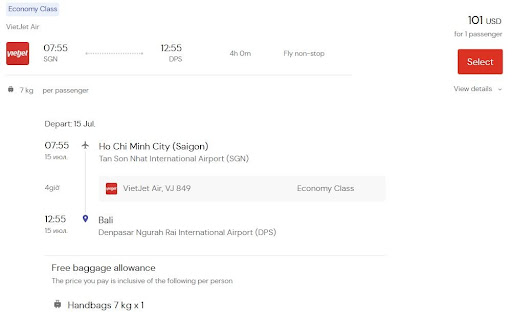
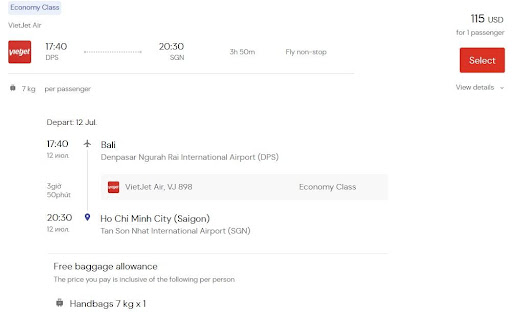
Ho Chi Minh City Overview
Ho Chi Minh City is a lively, modern metropolis with:
✨ A vibrant nightlife and an abundance of rooftop bars.
✨ A mix of historic landmarks and French colonial architecture from the 19th and 20th centuries.
✨ Many restaurants serving international cuisine, ideal if you’re craving non-Asian food.
While
the city’s colonial architecture is slowly disappearing, there are
still beautiful squares, historic streets, and preserved buildings that
reflect its French influence. It may not compare to Paris, but if you've
been living in Bali and miss classic European architecture, a visit to
Ho Chi Minh City could be refreshing.
Prices & Accommodation
Prices in Ho Chi Minh City (HCMC) are generally comparable to or lower than those in Bali, especially for food and accommodation. Budget travelers can find small hotels or guesthouses in central tourist areas for around 500,000 VND per night (~$20 USD).
If you haven’t booked accommodation in advance, there are many available options, particularly in the backpacker district of Phạm Ngũ Lão Street in District 1, where numerous hotels and hostels cater to tourists.
Getting from the Airport to the City Center
- The most affordable way to reach District 1 from Tan Son Nhat International Airport (SGN) is by taking a public bus: Bus 109 (Yellow Bus) – Air-conditioned, direct service to Pham Ngu Lao / Ben Thanh Market Bus 152 – Cheaper option but may be less comfortable Bus 103 – Not a common airport route (double-check if this service still operates)
- Bus 109 (Yellow Bus) – Air-conditioned, direct service to Pham Ngu Lao / Ben Thanh Market
- Bus 152 – Cheaper option but may be less comfortable
- Bus 103 – Not a common airport route (double-check if this service still operates)
- Cost: 15,000 - 20,000 VND (~$0.60 - $0.80 USD)
Alternatively, ride-hailing apps like Grab, Gojek, or Be are popular and affordable. A Grab car from the airport to District 1 costs around 100,000 - 150,000 VND (~$4 - $6 USD), depending on demand and traffic.
Currency Exchange & Payment Options
- Bring some USD as a backup, but there’s no need to exchange money at the airport. Banks and gold shops in the city generally offer better exchange rates.
- While Vietnamese dong (VND) is the official currency, USD is sometimes accepted in hotels, travel agencies, jewelry stores, and upscale restaurants. However, it’s best to use dong for local purchases.
- Credit & Debit Cards: Widely accepted in malls, supermarkets, hotels, and restaurants, though smaller shops and street vendors still prefer cash.
ATM Withdrawals
ATMs are widely available throughout the country, but some have withdrawal limits (often 2-3 million VND per transaction). The Vietnam-Russia Bank (VRB) has ATMs in six major cities where you can withdraw larger amounts:
- Hanoi
- Ho Chi Minh City
- Da Nang
- Vung Tau
- Hai Phong
- Khanh Hoa
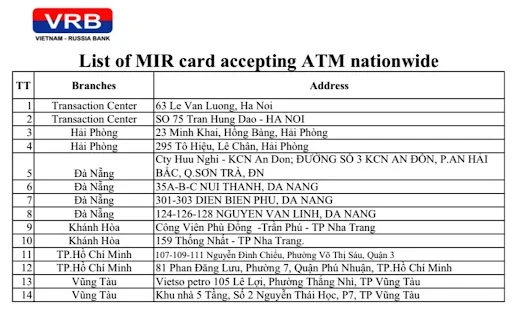
Buying a Local SIM Card
It’s best not to buy a SIM card at the airport, as prices are often inflated. Instead, visit an official store of major mobile providers such as MobiFone, Viettel, or Vinaphone. These stores ensure you get a properly registered SIM with an activated data plan.
- Basic SIM + Internet Plan Cost: Around 200,000 - 500,000 VND (~$8 - $20 USD) for one month, depending on the provider and data package.
- Always check that the internet plan is activated to avoid unexpected charges.
Getting Around the City
Taxis & Ride-Hailing Apps
- Reputable Taxi Companies: Mai Linh and Vinasun are the most reliable taxi operators in Ho Chi Minh City. Their cars have working meters and fair pricing.
- Taxi Fare Estimates: Base fare: 13,000 VND/km ($0.50 USD) Waiting time: 7,000 VND/min ($0.30 USD)
- Potential Scams: Some independent taxi drivers tamper with meters or charge inflated fares, so it’s best to use trusted companies.
Grab & Other Ride-Hailing Services
For a safer and more convenient option, use Grab (Vietnam's version of Uber).
With Grab, you can:
✅ See the price upfront before confirming your ride.
✅ Avoid communication issues, as everything is done via the app.
✅ Choose different types of transport (car, motorbike, even food delivery).
Other ride-hailing apps like Gojek and Be are also available.
Motorbike Transport
Motorbikes are the most common way to get around. You can:
- Rent one (if you’re comfortable navigating busy traffic).
- Use GrabBike for quick, cheap rides (~10,000-20,000 VND per trip).
- Hire a xe ôm (motorbike taxi), though prices may vary depending on negotiation.
Traffic & Rush Hours
Ho Chi Minh City has intense traffic, especially during rush hours:
- Morning: 7:00 AM - 8:30 AM
- Evening: 4:30 PM - 6:00 PM
If possible, avoid traveling during these times to prevent long delays.
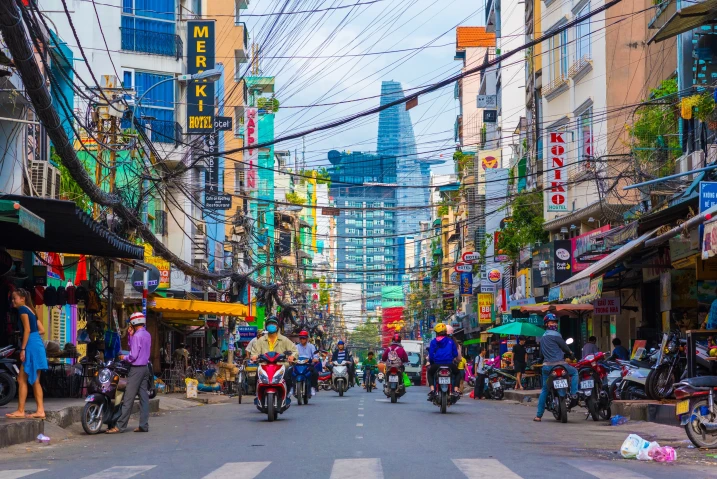
Activities & Attractions in Ho Chi Minh City
Landmarks & Architecture
Saigon Notre-Dame Cathedral
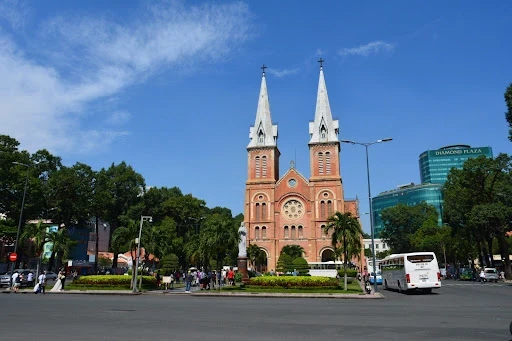
Built between 1877 and 1880, the Notre-Dame Cathedral Basilica of Saigon is a French colonial landmark in Neo-Romanesque style. Its iconic red bricks, imported from Marseille, remain intact. The two bell towers, added in 1895, stand at 57.6 meters and house six bronze bells. The Swiss-made clock (1887) is still functional.
Inside, the prayer hall accommodates 1,200 people, featuring a marble altar, Vietnam’s oldest pipe organ, and stone statues of saints. In front of the cathedral, the Our Lady of Peace statue (1959) is a well-known religious site.
The cathedral has been under restoration since 2017, with completion expected in 2027. While the interior remains closed, visitors can admire its exterior and the statue in the park.
Saigon Central Post Office
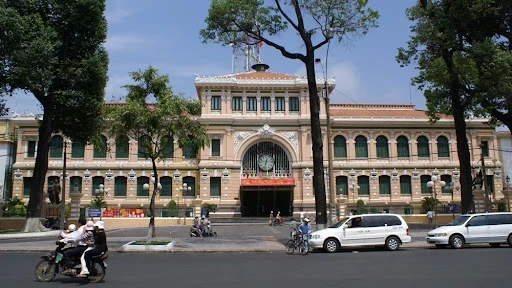
Built in 1891, the Saigon Central Post Office is a stunning example of French colonial architecture, blending Gothic and Renaissance styles. Often attributed to Gustave Eiffel, the actual design was by Alfred Foulhoux.
Inside, the grand vaulted ceilings, intricate marble floors, and antique phone booths transport visitors to another era. Large wall maps from 1892 depict old Saigon and its telegraph lines, while a portrait of Ho Chi Minh reminds visitors of Vietnam’s history.
Still a working post office, it offers postal services and souvenir shops. Located next to Notre-Dame Cathedral, it remains a must-visit landmark in Ho Chi Minh City.
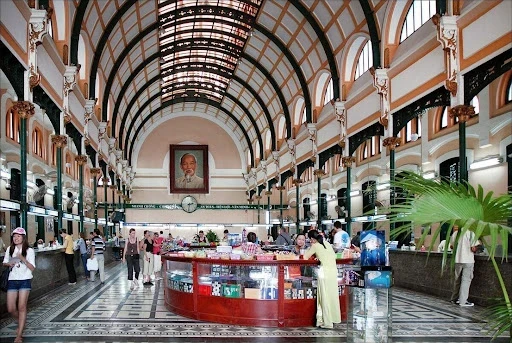
Ho Chi Minh City Hall
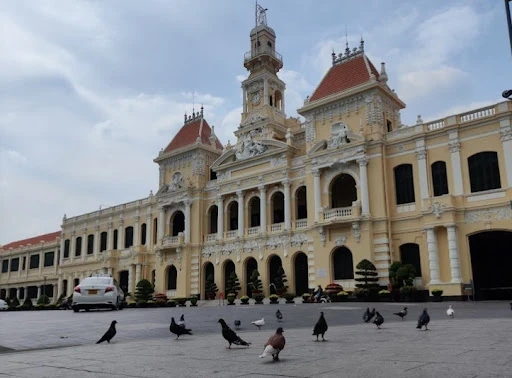
Built in 1909, Ho Chi Minh City Hall (formerly Hôtel de Ville de Saigon) is a French colonial landmark inspired by Paris City Hall. Designed by Fernand Gardès in a Neo-Baroque style, it originally served as the regional government headquarters.
After 1975, it was renamed the People’s Committee Building and remains closed to the public, but its elegant façade makes it a popular photo spot. In front of the building lies Nguyen Hue Walking Street, a lively central square with a statue of Ho Chi Minh, where locals gather, especially in the evenings.
Saigon Opera House
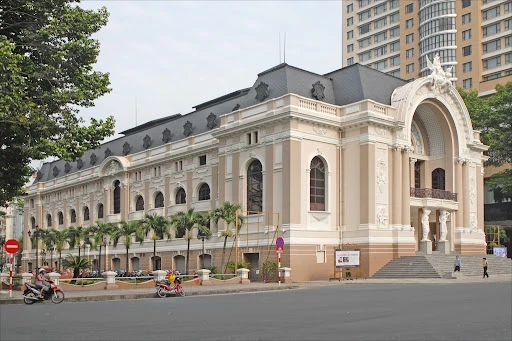
Built in 1900, the Saigon Opera House is a stunning French colonial landmark in the Beaux-Arts style, inspired by Parisian opera houses. Designed by Félix Olivier, Ernest Guichard, and Eugène Ferret, it originally hosted French theater performances.
During the Vietnam War, it was used as South Vietnam’s Lower House of Parliament, but after 1975, it was restored for cultural performances. A major renovation in 1998 brought back its original grandeur, and today, it hosts opera, ballet, concerts, and traditional shows. Located in Dong Khoi Street, it stands near the Continental and Caravelle Hotels.
Ben Thanh Market
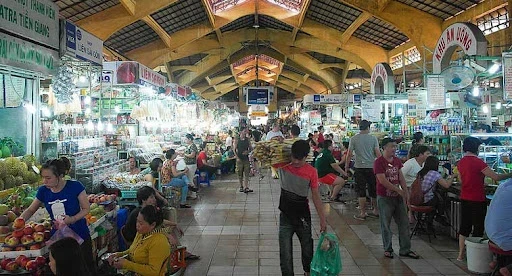
Ben Thanh Market, one of Ho Chi Minh City's most iconic landmarks, has been a bustling trade hub for over a century. Established in 1911, it was relocated to its current site and spans 13,000 square meters, featuring over 1,500 stalls.
Here, visitors can shop for clothing, handicrafts, souvenirs, fresh produce, and street food, experiencing the city's vibrant market culture. Open day and night, it becomes particularly lively in the evening with street food vendors and cafes.
While prices are often high for tourists, haggling is expected—start at half the asking price. Watch your belongings, as the market can get crowded. Whether shopping or just soaking in the atmosphere, Ben Thanh Market is a must-visit.
Hotel Majestic Saigon
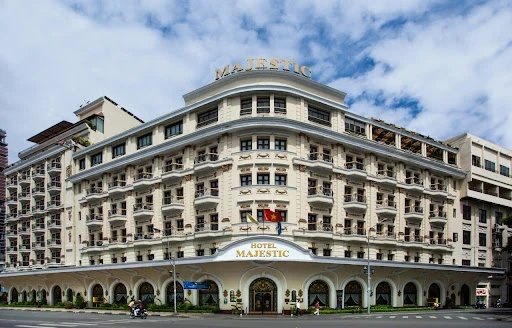
A historic and luxurious landmark in Ho Chi Minh City, Hotel Majestic Saigon has captivated guests since 1925 with its French colonial architecture and exceptional service. Originally built by Chinese-Vietnamese businessman Cùu Long Giang, the hotel blends Rococo and Baroque influences, creating a striking and elegant exterior.
Located along the Saigon River, the hotel offers stunning river and city views. It features a variety of rooms, including Superior, Deluxe, and river-view options. The top-floor M Bar offers panoramic views of the river, while multiple function rooms cater to special events.
For a romantic experience, the Serenade Restaurant serves French and international cuisine in an elegant setting, complete with live classical music and soft lighting. With a history as a hub for high-profile events, Hotel Majestic has hosted celebrities, politicians, and business leaders over the years.
Guests can also enjoy a range of amenities, including a pool, spa, and fine dining, all delivered with the warmth of traditional Vietnamese hospitality.
Hotel Continental Saigon
The Hotel Continental Saigon was built in 1878 and opened in 1880, designed by French businessman Pierre Cazeau as a luxurious hotel for French visitors. It quickly became a landmark of colonial Saigon. Over the years, the hotel hosted notable guests, including Rabindranath Tagore, Graham Greene, and André Malraux, and served as a gathering place for journalists, diplomats, and writers during wartime.
Located in the heart of Ho Chi Minh City, the hotel is just steps away from the Saigon Opera House and other key attractions. Its architecture is purely French colonial, preserving an authentic 19th-century aesthetic. The hotel features elegant interiors, a historic dining hall, and a charming courtyard.
History & Museums
War Remnants Museum
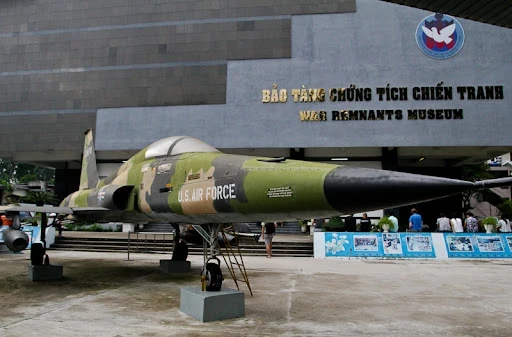
The Vietnam War Remnants Museum offers a powerful and immersive exploration of the Vietnam War, its origins, and lasting consequences. Located in a striking building, the museum features an extensive collection of exhibits, including photographs, documents, and military equipment that illustrate the scale of the conflict and its impact on Vietnam and the world.
Visitors can view historical military artifacts such as tanks, cannons, and helicopters in the courtyard, though climbing on them is prohibited. Inside, the museum showcases poignant photo exhibitions, including images of victims of chemical attacks, disfigured by napalm and phosphorus bombs, and the lasting effects on future generations. The museum also displays moving children's artwork, reflecting the pain caused by Agent Orange exposure.
With a ticket price of 40,000 VND ($1.70), the museum is open daily from 7:30 AM to 5:30 PM. It's a place for reflection on the value of human life and the lasting scars of war.
Cu Chi Tunnels
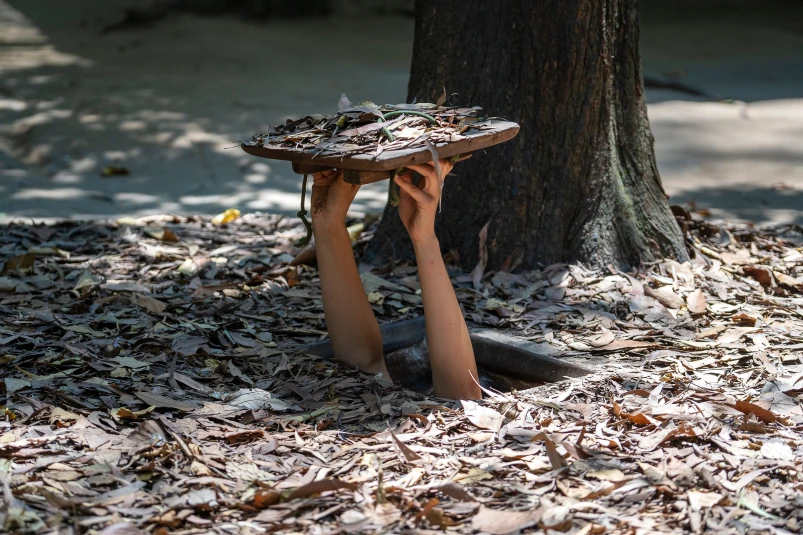
The Cu Chi Tunnels, located about 50-55 km from Ho Chi Minh City, are a historic network of underground tunnels used by Viet Cong soldiers during the Vietnam War. Today, they are a popular tourist attraction, offering insight into the harsh conditions faced by the soldiers.
The site features displays of American military equipment, ammunition, and a collection of deadly traps used by the Viet Cong. Visitors can learn about the traps' operation and even test their skills in spotting hidden tunnel entrances. Brave souls can descend into the tunnels and experience life underground, while the adventurous can sample guerrilla food. For a full meal, there’s a café nearby, though prices are higher.
Since there’s no direct bus service, booking a guided tour for around $18 is the most convenient option, including transportation. Tours are available at various tourist centers in Ho Chi Minh City.
Independence Palace
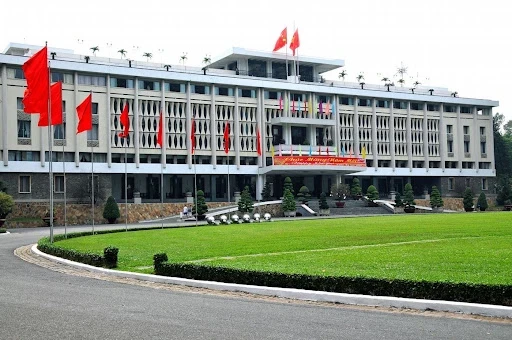
The Independence Palace, once the residence of the President of South Vietnam, is
now a museum open to the public. Visitors can explore preserved rooms,
including presidential offices, meeting rooms, and underground command centers,
offering a glimpse into the Vietnam War era. The palace also displays
photographs, documents, and exhibits related to Vietnam’s history and key
events.
Ticket
cost: 40,000 VND ($1.70)
Opening hours: Daily, 8:00 AM to 3:30 PM
Vietnam History Museum
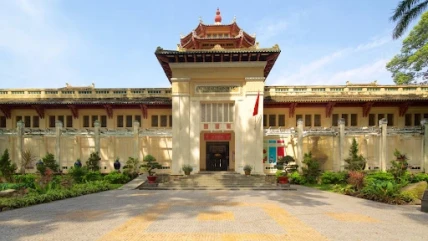
The
Vietnam History Museum, established in 1927, is a key cultural institution
dedicated to the country’s rich history and diverse heritage. Designed by
French architect Delaval in a style influenced by Chinese traditions, the
museum showcases over 32,000 exhibits, including artifacts, rare documents,
maps, and artworks.
The
museum’s 17 galleries cover various historical periods, with notable
collections on Vietnam's Stone Age, ethnic minorities, Buddhism, and Hinduism.
Although the museum offers a comprehensive look at ancient and traditional
cultures, it lacks in-depth coverage of Vietnam's colonial and 20th-century
history.
Ticket
cost: 30,000 VND ($1.20)
Opening hours: Daily, 8:00 AM to 5:00 PM (closed 11:30 AM to 1:00 PM for
lunch)
Ho Chi Minh City Museum
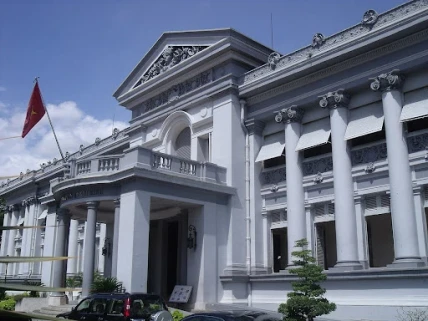
The
Ho Chi Minh City Museum, housed in a historic mansion once home to the French
governor and later President Ngo Dinh Diem, blends French colonial architecture
with traditional Eastern design. The museum offers a comprehensive look at the
city's history, featuring archaeological artifacts, historical maps,
photographs, and cultural exhibits.
Key
highlights include a display of ancient city maps, showcasing the evolution of
Ho Chi Minh City from its earliest days, and a fascinating exhibit on wedding
rituals across Vietnam's ethnic groups. Another notable exhibit traces
Vietnam’s struggle for independence, presenting personal items from war
participants and historical insights.
The
museum also features military equipment and offers a glimpse into the
city's role in Vietnam's broader history.
Ticket
cost: 30,000 VND ($1.20)
Opening hours: Daily, 8:00 AM to 5:00 PM
Nha Rong Wharf (Dragon Wharf)
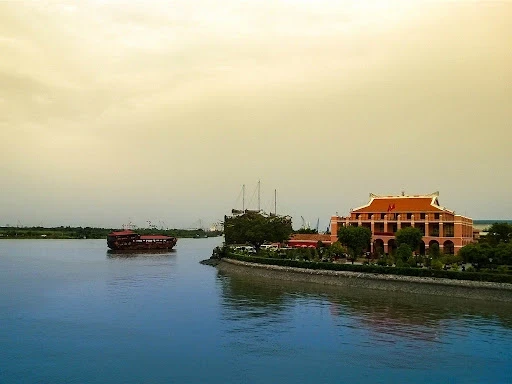
Located
in District 4, Nha Rong Wharf is a historically significant site, once Saigon's
main trading port during French colonial rule. Built in the early 20th century,
it was originally the headquarters of the French shipping company Messageries
Maritimes. The building, adorned with two large blue terracotta dragons, is
notable for both its architectural beauty and its role in Vietnam's political
history.
This
site holds particular importance as the location where Ho Chi Minh (Nguyen Ai
Quoc) departed in 1911 to begin his fight for Vietnam’s independence. Today,
the building serves as the Ho Chi Minh Museum, showcasing the life and legacy
of the revolutionary leader.
The
site also offers scenic views of the Saigon River and the city, making it a
popular spot for both history enthusiasts and visitors enjoying the landscape.
Ticket
cost: Variable (check local sources)
Opening hours: Typically 8:00 AM to 5:00 PM
Activities & Entertainment
Vincom Ice Rink (Vinpearl Land)
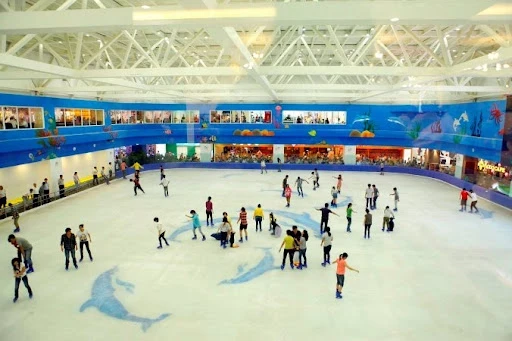
Located
in the Vinciti shopping center, the Vinpearl
Land Ice Skating Rink offers a fun and safe ice skating experience with modern
facilities and regular maintenance.
Pricing:
- Children up to 140 cm: 100,000 VND ($4.20); 150,000 VND ($6.30) on weekends/holidays
- Adults (over 140 cm): 170,000 VND ($7.20); 220,000 VND ($9.10) on weekends/holidays
- Operating hours: 9:30 AM to 10:00 PM
- Ticket includes all equipment. For beginners, there are support penguins to help children glide on the ice.
Facilities
& Extras: The shopping center also has restaurants, cafes, and a
supermarket with a variety of products. Regular events like figure skating
performances and hockey matches add to the entertainment.
Push Climbing Gym

Push
Climbing Gym in the Thao Dien district features 9-meter walls and bouldering zones,
making it a great spot for both beginners and experienced climbers. It’s the
tallest climbing wall in Saigon, with 30 routes of varying difficulty and 6
self-belaying devices.
Pricing:
- Standard 1-hour pass (without gear): 150,000 VND ($6.30)
- Gear rental (shoes, harness, chalk bag): 50,000 VND ($2.10)
- Special days: Wednesdays for girls and Thursdays for boys, entrance fee 100,000 VND ($4.20)
Facilities:
The gym includes 2 bouldering zones (70 sq. meters), a small climbing gear
shop, and a café for post-climb relaxation. Qualified trainers provide guidance
on techniques and safety, and the atmosphere is friendly and supportive.
Location:
The gym is accessed from a side street opposite Vinmart supermarket, not from
the main street.
Vertical Academy Climbing Gym
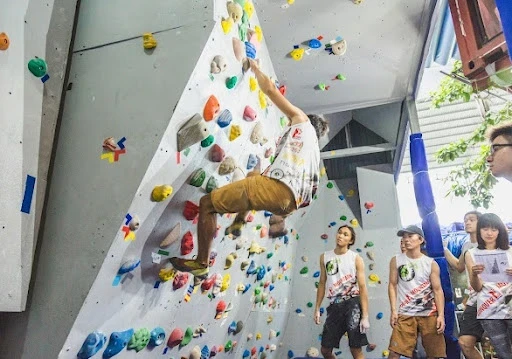
Vertical
Academy, a popular climbing gym and entertainment center, opened in June 2018.
While it doesn’t feature tall walls, it offers a 100-square-meter bouldering
area with a height of 4.5 meters.
Pricing:
- Standard day pass: 150,000 VND ($6.30), including climbing shoes and instructor assistance
- Beginner sessions (Wednesdays): 200,000 VND ($8.50) for adults
Facilities
& Activities: The gym offers routes for all skill levels, with
professional instructors available for guidance. Workshops and training
sessions are also offered for climbers looking to improve their skills. The gym
hosts competitions, themed events, and children's parties, making it a fun
destination for all ages.
Dam Sen Water Park
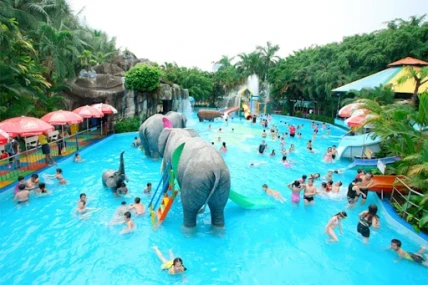
Dam
Sen is one of Vietnam’s largest and most modern water and amusement parks,
covering 50 hectares, with lush greenery (60%) and water spaces (20%). It
offers a peaceful green escape within the city.
Key Features:
- The park's decor blends global styles, including Japanese tea houses, a bonsai garden, Roman square, and an ice house.
- A garden home to 80 bird species and 30 rare animals like tigers, leopards, and elephants, along with a crocodile farm.
- Attractions include roller coasters, rafting, a haunted castle, and a dinosaur-themed area with giant dino shows.
- The water park has a variety of slides, including the 19-meter "Kamikaze" slide, wave pool, "Tornado" tube, and a zipline. There are also special areas for kids like Aqua Dance and a children's pool.
Pricing:
- Amusement park: 100,000–360,000 VND ($4.20–$15.20)
- Water park (adults above 1.4 meters): 150,000 VND ($6.30) during the day, 120,000 VND ($5) after 4 PM
- Water park (children below 1.4 meters): 110,000 VND ($4.60) during the day, 80,000 VND ($3.40) after 4 PM
- Storage: 20,000 VND ($0.85)
Facilities:
Restaurants, cafes, massage salons, saunas, and beauty salons are available.
The park operates from 9:00 AM to 5:30 PM and gets busy on weekends.
Getting
There: Located outside the city center, reachable by taxi or bus
routes 15, 64, 144, 62, and 69.
Shopping Destinations
Vincom Center
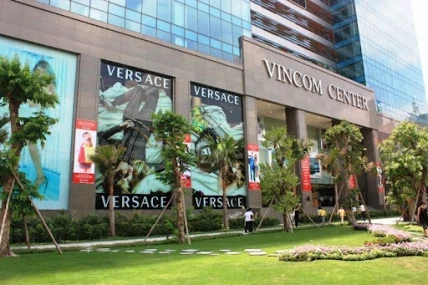
Located
in the city center, Vincom Center is a convenient shopping destination with a
range of international brands like H&M, Zara, Mango, Pull & Bear,
Stradivarius, and Charles & Keith. The mall spans 7 floors, both above and
underground, and offers a variety of cafes and restaurants.
Key Features:
- Shopping: Fashion, cosmetics, accessories, and a supermarket on the lowest floor with fresh produce and meats.
- Dining: Affordable eateries with meals starting at around 50,000 VND ($2).
- Books & Souvenirs: A bookstore with stationery, souvenirs, and unique items like elegant Chinese teapots.
- Facilities: Several ATMs, including a Citibank ATM.
Nearby:
Across the street, you'll find Parkson Plaza and Union Square department
stores, offering premium brands. There’s also a small square with benches for a
relaxing break.
Binh Tay Night Market
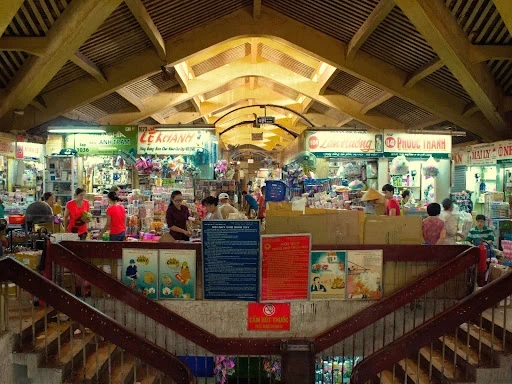
Located
in Chinatown, Binh Tay Market, built in the 1880s, is a local favorite,
catering mostly to residents rather than tourists. It opens after sunset and
runs until late, with the best time to visit being early evening. By 6:00 PM,
many stalls begin closing, though nearby vendors may still be active.
Key Features:
- Shopping: A wide range of goods, including clothing, shoes, bags, accessories, souvenirs, and local handicrafts.
- Food: Popular Vietnamese street food like banh mi (sandwich), banh beo (steamed rice cakes), and pho (noodle soup).
- Atmosphere: A lively spot to observe local life, offering a more authentic experience compared to tourist-heavy markets.
Practical Info:
- Located outside the city center but accessible by Grab or bus. Return buses can be found at Ben Thanh Bus Station (Bến xe Chợ Lớn).
- Limited pedestrian space and smaller sizes for clothes may be a challenge. The market is also close to Chinese temples and pagodas in Chinatown.
An Dong Market
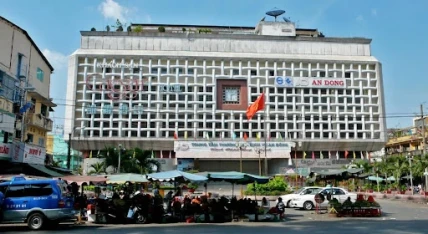
An
Dong Market, located in Chinatown, is one of the oldest markets in South
Vietnam and offers a local shopping experience. It's a hub for everything from
jewelry to dried fruits, with a variety of shops selling clothing, handicrafts,
and local delicacies.
Key Features:
- Shopping: The market spans several floors, with the first floor offering dried goods, coffee, and jewelry. The second floor is for shoes, and the third and fourth floors feature clothing, with souvenirs like lacquer paintings and carved wooden figures on the fourth floor.
- Clothing: Predominantly Chinese-style, with bright colors, sequins, and synthetic fabrics. Larger clothing and shoe sizes may be hard to find, as the market caters mainly to locals.
- Bargaining: Prices are generally lower than at tourist-heavy markets like Ben Thanh, and bargaining is encouraged.
Nearby:
Just a few hundred meters away, An Dong Plaza offers a more modern shopping
experience with similar goods but a slightly different selection, including
more youth-oriented fashion.
Practical
Info:
- Open 6:00 AM to 6:00 PM.
- Easily accessible from District 1 by bus (5,000-6,000 VND, $0.20).
- A visit here pairs well with exploring nearby Chinese pagodas in Chinatown.
Art & Culture
Apricot Gallery
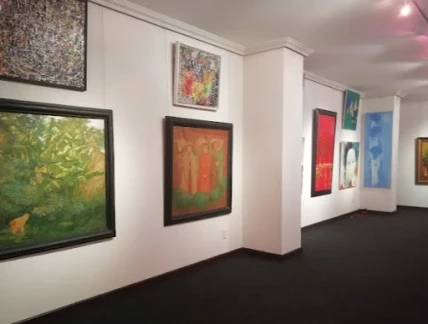
Located
in the city center, the Apricot Gallery offers a perfect blend of contemporary
Vietnamese art and the historic French colonial architecture nearby.
Key Features:
- Exhibitions: Spanning three floors, the gallery showcases a diverse collection of contemporary art from about 50 local artists, many from Hanoi and surrounding areas. Works include paintings, sculptures, drawings, and photographs.
- Notable Artists: Featured artists include Bui Huu Hung, known for portraits of Vietnamese women, and Dao Hai Phong, who presents surreal rural landscapes.
- Artistic Focus: The gallery promotes Vietnamese art, fosters cultural exchange, and hosts events for public engagement with art.
Opening Hours:
10:00 AM - 8:00 PM.
Recognition: The Apricot Gallery
is considered one of Vietnam’s leading galleries, renowned for its high-quality
contemporary art.
Vietnam Art Gallery
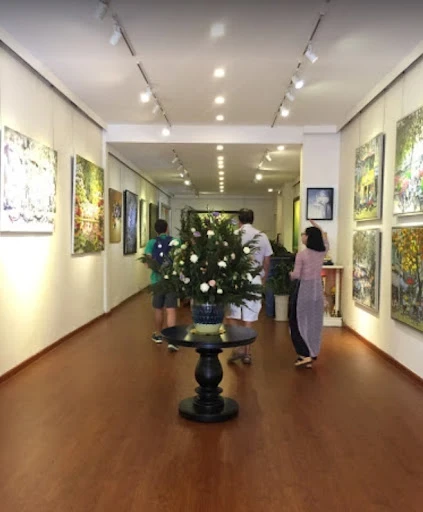
Located
on the central square, Vietnam Art Gallery is a convenient stop while exploring
the city. It showcases a curated collection of contemporary and traditional
Vietnamese art.
Key Features:
- Prime Location: Easily accessible during a city stroll.
- Diverse Collection: Features works by emerging and established Vietnamese artists.
- Cultural Insight: Offers a glimpse into Vietnam’s rich artistic heritage.
Perfect for art lovers and casual visitors alike.
Opening hours: 10:00 AM - 7:00 PM
Ben Tan Gallery
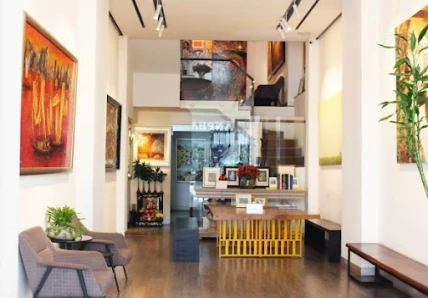
Ben Thanh Art Gallery, established in 1999, is a prominent fine
art gallery in Ho Chi Minh City. It showcases a
diverse collection of artworks, including pieces from renowned artists such as
Le Pho, Vu Cao Dam, and Mai Trung Thu, as well as war-era propaganda art and
contemporary works.
The gallery operates two
locations in District 1:
- 7 Nguyễn Thiệp Street: This location offers a variety of contemporary Vietnamese art and provides framing services.
- 159 Đồng Khởi Street: Situated in a bustling shopping area, this branch features an extensive range of modern Vietnamese art.
Both locations are open daily
from 9:00 AM to 9:00 PM.
Visitors can expect a wide
array of artworks, including paintings, sculptures, and photographs,
representing both traditional and contemporary Vietnamese art.
Bars with a View
For an unforgettable experience, visit one of the city's
open-air rooftop bars.
These bars offer:
🌆 Breathtaking views of the skyline.
🎶 Lively music & a great atmosphere.
🍹 Cocktails & fine dining.
From these rooftop spots, you won’t just see the city—you’ll
feel its energy and hear its heartbeat as it rapidly evolves into a modern
global hub. 🚀
Sky Deck at Bitexco Financial Tower
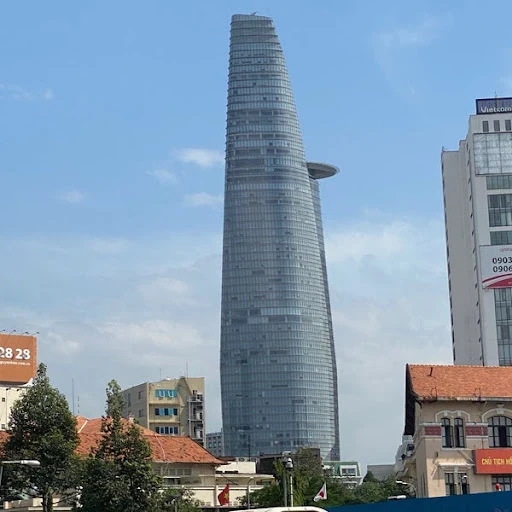
Completed
in 2010, Bitexco Financial Tower was once the tallest skyscraper in Vietnam,
standing at 262 meters with 68 floors. The tower houses a popular tourist
attraction, the Sky Deck on the
49th floor, offering breathtaking views of the city and the Saigon River. Two
restaurants are located on the 50th and 51st floors, adding to the tower’s
appeal.
Alto Heli Bar at Bitexco Financial Tower
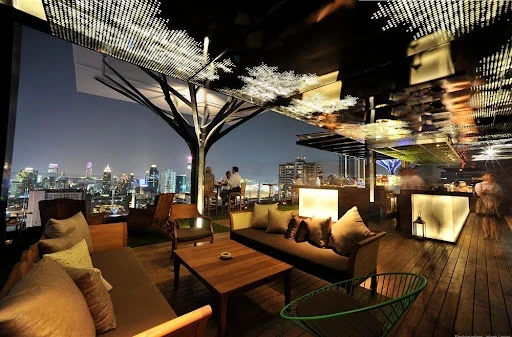
Located
on the 52nd floor of Bitexco Tower, Alto
Heli Bar is the highest point in Ho Chi Minh City, offering stunning
panoramic views of the skyline. The modern lounge, with its soft lighting,
comfortable seating, and unobstructed views, is the perfect spot for sunset or
late-night drinks.
- Opening Hours: 10:00 AM – 02:00 AM
Chill Skybar
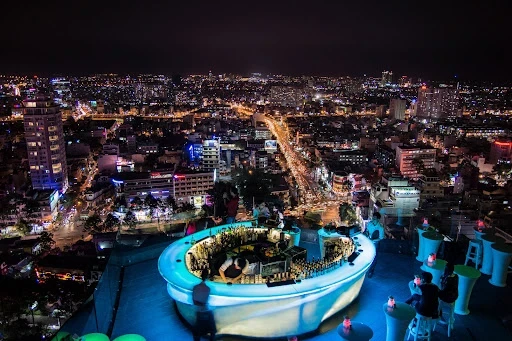
One
of the city’s most stunning open-air bars, Chill Skybar is located on the 25th floor and provides
an incredible 360-degree view of Ho Chi Minh City. It’s particularly popular at
sunset for its scenic views. During happy hour, enjoy discounted drinks, and
later in the evening, the bar hosts parties and DJ performances.
- Opening Hours: 4:00 PM – Late (parties from Thursday to Sunday)
Above Skybar
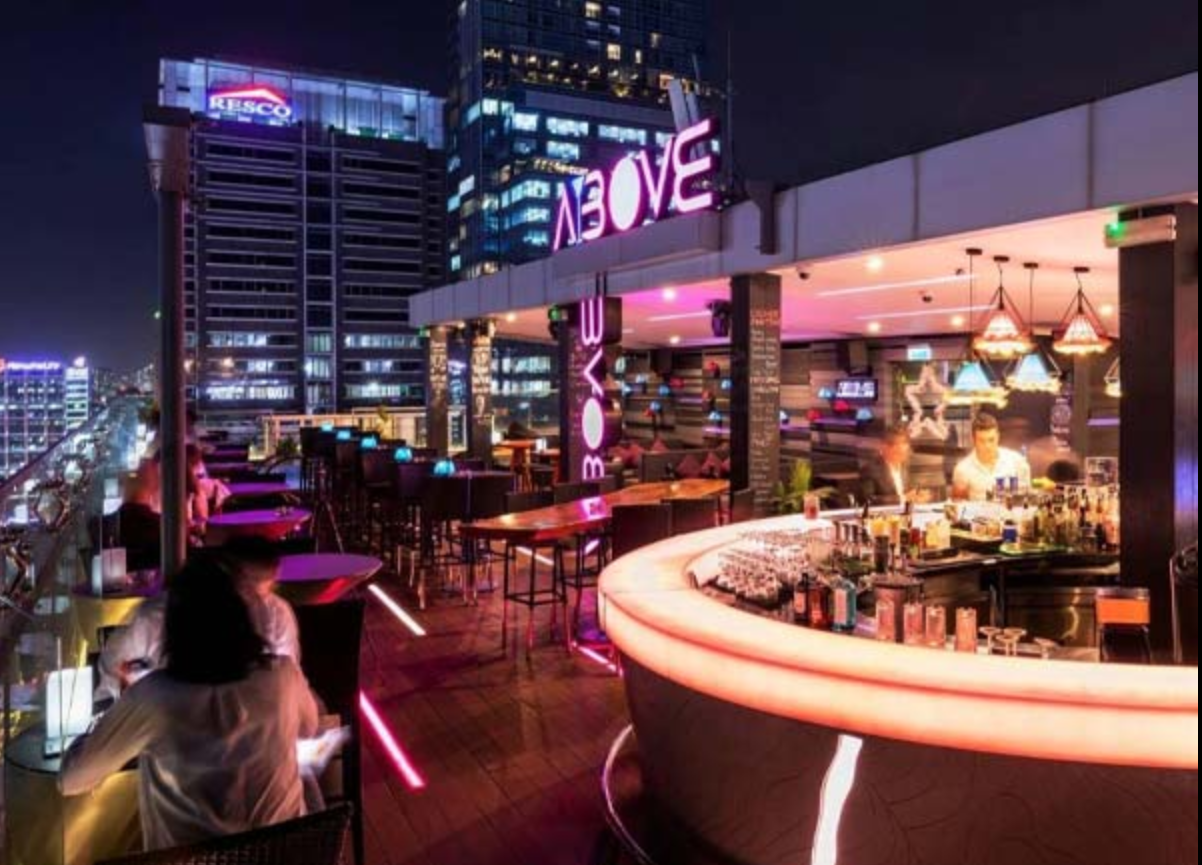
Above Sky Bar is located on the 18th floor of Liberty Central Saigon Citypoint Hotel in District 1. It offers panoramic views over the central square and Saigon's downtown skyline. The rooftop bar features a stylish open-air setting, a rooftop pool, and a laid-back atmosphere—ideal for sunset cocktails or evening drinks.
Non-hotel guests can also access the pool area for a small fee, making it a great spot to unwind with a view, even if you're not staying at the hotel.
- Opening Hours: 10:00 AM – 10:00 PM (times may vary)
Level 23 Wine Bar
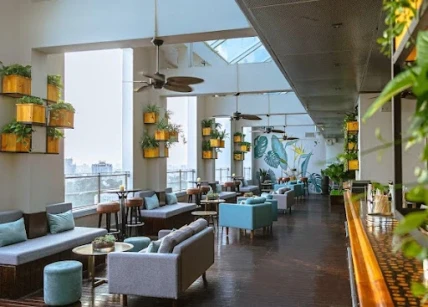
Perched
on the 23rd floor of the Sheraton Hotel, Level
23 Wine Bar offers a comfortable space with panoramic views of Ho Chi
Minh City’s central square. The bar is protected from the wind and light rain,
making it an ideal spot for a drink with uninterrupted views. Guests can also
enjoy complimentary snacks with drinks.
- Opening Hours: 11:00 AM – 1:00 AM
Lighthouse Sky Bar
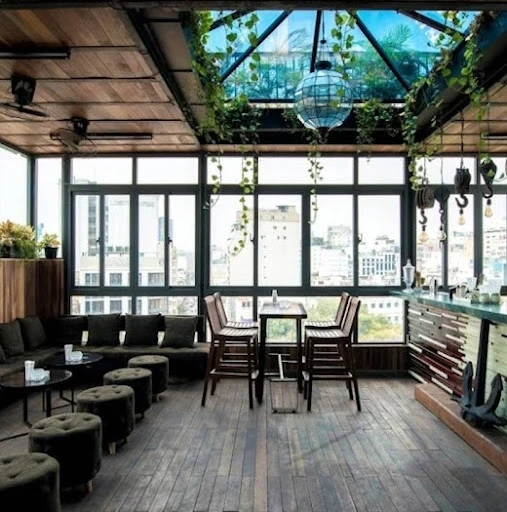
Though
located on the 6th floor, Lighthouse Sky
Bar is worth visiting for its open terraces on the 7th and 8th floors.
These terraces offer great views of the city, and there are bar counters for
enjoying drinks while soaking in the surroundings. On Wednesdays, the bar hosts
Lady's Night with free entry and
drinks for women.
Additionally, the bar serves coffee, embracing
Vietnam’s rich coffee culture, which is integral to local life. Vietnam’s
coffee is strong, aromatic, and typically served "cà phê đá" (iced
coffee with condensed milk).
- Opening Hours: 5:00 PM – Late
These
bars are perfect for experiencing Ho Chi Minh City from above, offering a mix
of stylish atmospheres, scenic views, and enjoyable evening events.
Food & Drink
L'Usine
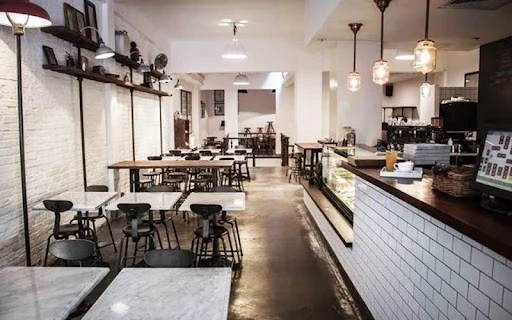
L'Usine is a distinguished lifestyle destination in Ho Chi Minh City,
seamlessly integrating a café, boutique, and art gallery. This establishment offers visitors a harmonious blend of
modern and vintage aesthetics.
Locations:
· Dong
Khoi Street: Situated at 151 Đồng Khởi, 1st Floor, District 1, this
location is housed in a historic 1890s building that once served as the Hotel
du Saigon. The space features 20-foot ceilings, oversized arched windows, and
ornate iron columns.
· Le
Loi Street: Located at 70B Lê Lợi Street, District 1, this branch
occupies a colonial-era French building. The ground floor showcases a boutique
with a curated selection of clothing, accessories, and homewares. An
extraordinary spiral staircase leads to the spacious café above, designed as a
Panini bar serving all-day hot Paninis, refreshing beverages, and their
renowned cupcakes.
Culinary Offerings:
The café's menu features a variety of gourmet items, including baguette
sandwiches, salads, and an assortment of espresso coffees. Notably, the
Vietnamese coffee is praised for its authentic preparation and distinctive
fruity-caramel aftertaste. Prices are above average, with a royal Vietnamese
coffee priced at 75,000 VND. Additionally, taxes are added to the bill on top
of the listed prices.
Boutique and Art Gallery:
L'Usine's boutique offers a curated selection of contemporary fashion,
accessories, and homewares, featuring both local and international designers. The
attached gallery space provides a platform for local artists to showcase their
work, adding an artistic dimension to the shopping experience.
Ambiance:
The interior design reflects an urban industrial sophistication, with high
ceilings and a spacious loft setting that invites patrons to relax and immerse
themselves in the environment.
L'Usine stands out as a multifaceted venue that captures the essence of Ho
Chi Minh City's dynamic culture, making it a must-visit destination for both
locals and tourists.
The Workshop Coffee
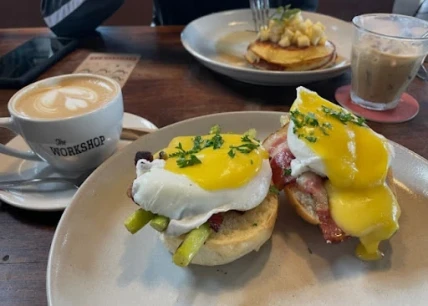
Established in 2014, The Workshop Coffee is located on the top
floor of a building at 27 Ngô Đức Kế, Bến Nghé, District 1, Ho Chi Minh City.
It is recognized as the city's first specialty coffee
roastery.
Ambiance and
Facilities:
- The café features an industrial design with high ceilings and abundant natural light.
- It offers a spacious environment with long tables, making it suitable for both casual visits and coworking.
- Complimentary water is provided, and the atmosphere is enhanced with pleasant music.
Coffee and
Menu:
- The Workshop offers an extensive coffee selection, including espresso, pour-over, AeroPress, and siphon methods.
- Vietnamese iced coffee is recommended for its creamy texture and rich flavor.
- The menu also includes breakfast and lunch options, with dishes like pasta and Eggs Benedict.
Pricing:
- An espresso is priced around 60,000 VND (approximately $2.50 USD).
Additional
Features:
- The café is adorned with contemporary art and offers a modern yet distinctly Saigonese atmosphere.
- Guests can engage in activities like chess, adding to the café's vibrant community feel.
The Workshop Coffee
seamlessly combines quality brews, a conducive work environment, and a touch of
local culture, making it a notable spot in Ho Chi Minh City's café scene.
C+ Cafe
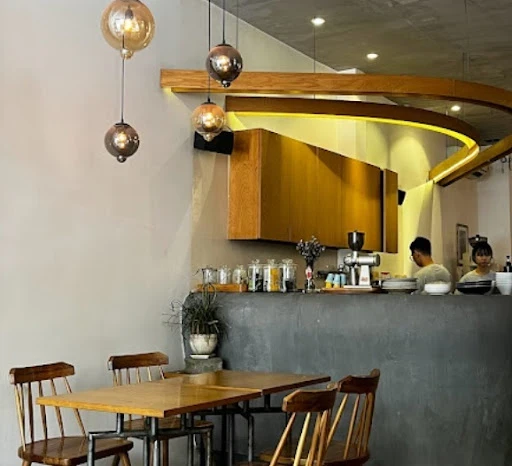
C+ Cafe, located at 230 Nguyen Thi Minh Khai in District 3, Ho Chi Minh City, offers a blend of art and culinary delights. The café features a spacious and relaxing environment, often hosting design exhibitions.
Vietnamese-style coffee is affordably priced at approximately 35,000 VND (around $1.50), served with a generous, frothy foam in a regular cup. Instead of standard drinking water, a light tea accompanies the coffee.
The second-floor open-air gallery provides a vantage point for observing the city's lively streets. The detailed food menu, complete with photos for each dish, simplifies selection.
Maison Marou Flagship Saigon
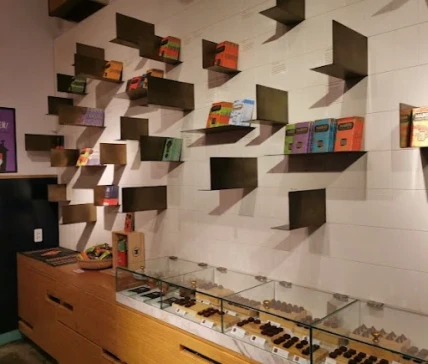
Maison Marou Flagship Saigon, located at 167-169 Calmette Street in District 1, is a renowned café and chocolatier offering a comprehensive bean-to-bar chocolate experience. Visitors can observe the chocolate-making process firsthand, enhancing their appreciation for the craft.
The café serves a variety of chocolate products, including traditional bars, pralines, pastries, and beverages like hot chocolate. Notably, the hot chocolate infused with chili and cinnamon comes highly recommended.
The establishment also features a retail section where patrons can purchase artisanal chocolates and related gifts.
While the atmosphere is vibrant and bustling, it may appeal more to those seeking an energetic environment rather than a quiet retreat.
Maison Marou Flagship Saigon stands out as a must-visit destination for chocolate enthusiasts in Ho Chi Minh City.
Partea – English Tearoom
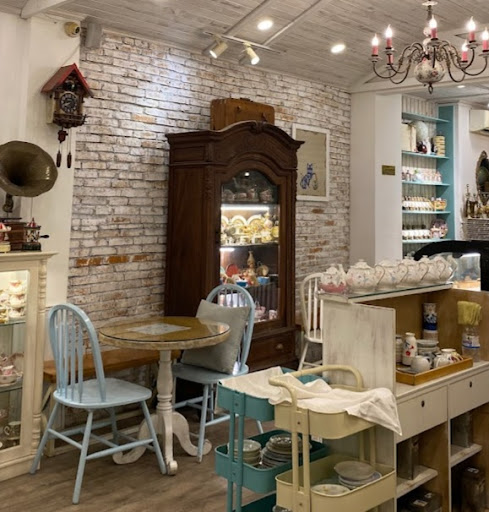
Partea – English Tearoom, located on the 4th floor of 42 Nguyen
Hue Street in District 1, Ho Chi Minh City, offers a charming English-style tea
experience. Upon entering, guests are invited to
remove their shoes, enhancing the cozy and homely ambiance. The interior is adorned with whimsical decorations reminiscent
of "Alice in Wonderland," creating a delightful atmosphere.
Tea Selection
and Service:
- An extensive variety of teas is available, allowing guests to choose their preferred blend.
- Patrons can select from a collection of uniquely designed teacups, adding a personalized touch to their tea experience.
Additional
Offerings:
- A selection of pastries and cakes complements the tea, enhancing the traditional English tea experience.
- A cozy seating area offers views of Nguyen Hue Street, allowing guests to enjoy the vibrant cityscape.
Partea provides a unique and
immersive setting for tea enthusiasts and those seeking a distinctive
experience in Ho Chi Minh City.
Phuc Long
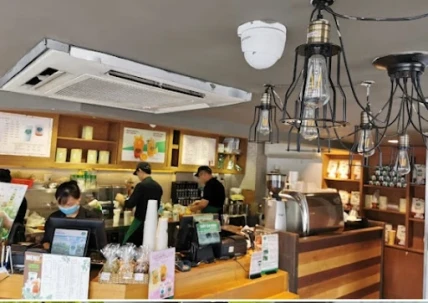
Phuc Long Coffee & Tea, established in 1968, has become a prominent Vietnamese brand renowned for its high-quality coffee and tea offerings.
With numerous locations across the country, it provides a modern, minimalist ambiance similar to international coffee chains.
The menu features a variety of beverages, including Vietnamese coffee, matcha lattes, and specialty drinks like the Choco Lover.
Additionally, Phuc Long offers packaged teas and roasted coffee, making it a favored destination for both locals and visitors seeking authentic Vietnamese flavors.
Villa Royale Antiques & Tea Room
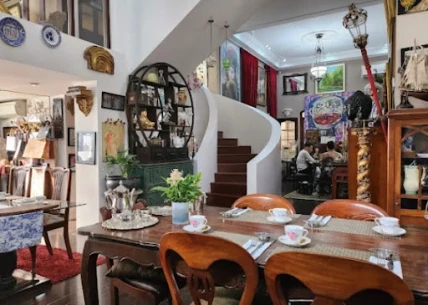
Villa Royale Antiques & Tea Room, combines an antique shop with a tea room in a 1930s-era building.
Founded by Australian David Campbell, the establishment offers a selection of over 50 teas, including varieties from the Singaporean brand TWG.
The ambiance, reminiscent of a French antique collector's home, provides a leisurely setting for patrons to enjoy extended tea sessions.
Tous les Jours (Bakery Chain)
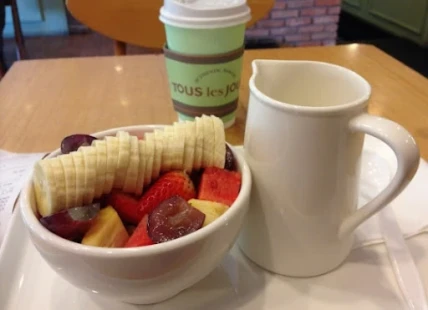
Tous les Jours, a South Korean bakery
chain established in 1997, has multiple locations throughout Ho Chi Minh City.
Known for its French-Asian-inspired baked goods, the
bakery offers a variety of freshly prepared items, including bread, cakes,
danishes, and croissants. Among their offerings is
the Cream Cheese Walnut Bread, a popular choice featuring a blend of cream
cheese and walnuts. Additionally, Tous les Jours
provides a selection of beverages to complement their baked goods.
Sweet + Sour Bakery
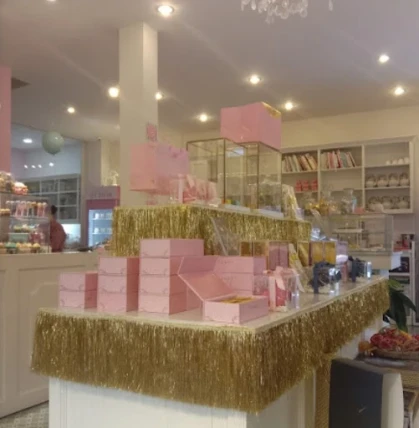
Sweet + Sour Bakery, established in
2010, is located at 9 Ngo Quang Huy, Thao Dien, District 2, Ho Chi Minh City.
This boutique bakery and café offers a variety of freshly
baked goods, including appetizing cakes and delicate macarons. The cake flavors range from classic vanilla to salted caramel,
lime coconut, and a unique cà phê sữa đá—a creative interpretation of
Vietnamese iced coffee with milk. Guests can enjoy
their treats in the outdoor courtyard, providing a pleasant setting for
relaxation. The bakery operates daily from 8:00 AM
to 7:00 PM.
Brodard Bakery
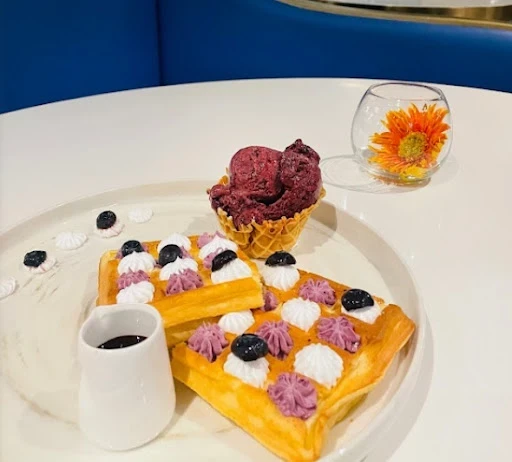
Brodard Bakery, established in 1948, is
a renowned patisserie in Vietnam. Known for its high-quality baked goods, Brodard offers a wide
selection of specialty breads, pastries, cookies, and cakes. While the bakery is celebrated for its French-inspired offerings
like croissants and gateaux, it also provides a variety of traditional
Vietnamese desserts. For instance, they serve Chè
Bà Ba, a coconut milk-based dessert with taro, cassava, and sweet potato.
Additionally, their menu features items such as the
Passion Fruit Mousse and Pineapple Cake Slice, showcasing a blend of local
flavors and classic pastry techniques.
PAUL Bakery
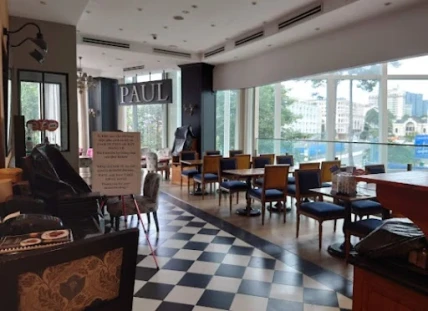
Opened in early 2017, PAUL Bakery brings authentic French
flair to Ho Chi Minh City with its upscale menu of pastries, sandwiches, and
classic French dishes. Known for its elegant European-style
interior—chandeliers, tall windows, and ambient music—PAUL offers a refined
dining experience. Prices are above average, but the quality and presentation
make it worth the splurge.
Le Petit Bake and Cake
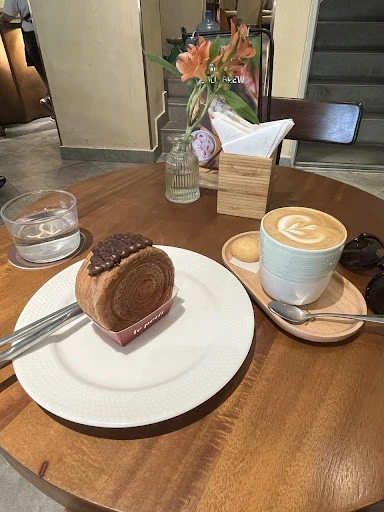
A boutique bakery in Ho Chi Minh City known for its artisanal pastries and custom-designed cakes. Le Petit stands out for its creative presentation and attention to detail, offering a variety of unique flavors in a cozy, stylish setting.
Street Food & Local Cafés
Snacks and meals are everywhere in Saigon—from street stalls to international
restaurants. Street vendors often specialize in just one or two dishes like pho (from 40,000 VND) or rice with meat (from 30,000 VND). Banh mi stalls (from 20,000 VND) and sugarcane juice
stands (from 10,000 VND) are common. Vietnamese
coffee, including the local favorite egg coffee, can be found on nearly every corner—street
prices start at 15,000 VND, while cafés charge around 30,000–50,000 VND.
Strolls & City Walks
From buzzing nightlife streets to quiet, history-filled boulevards, Ho Chi Minh City offers plenty of places perfect for a scenic stroll and a glimpse into its vibrant culture.
Bùi Viện Walking Street
Located in the heart of the backpacker district, Bùi Viện Street is Ho Chi Minh
City’s nightlife hub, known for its non-stop energy, street performances,
budget bars, and diverse crowd. It's a popular spot for backpackers, with
hostels starting as low as $4 per night,
though the area can get loud, chaotic, and crowded—especially in the evenings.
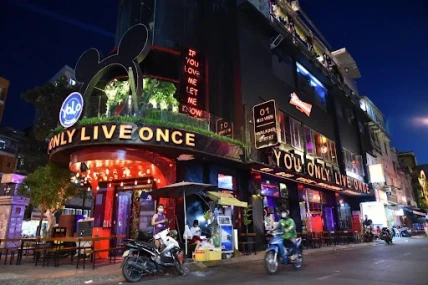
Expect cheap
eats, loud music, souvenir stalls, and nightlife entertainment
including live music and karaoke.
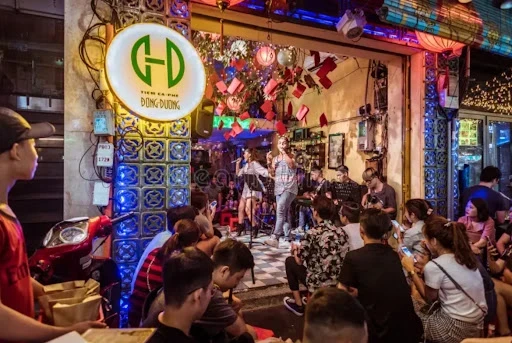
For a calmer experience, nearby Phạm Ngũ Lão Street offers a more relaxed vibe, tree-lined sidewalks, and bus ticket offices for travelers heading across Vietnam.
District 1 – The Nostalgic Heart of Saigon
Often
referred to as the Old Quarter, District 1 is the historic and cultural center
of Ho Chi Minh City. It features a blend of
French colonial architecture, charming villas, temples, and tree-lined
streets. Ideal for walking, the district is filled with cafés, galleries, boutiques, and historic landmarks.
Key highlights include:
- Nguyễn Huệ Walking Street – a pedestrian boulevard popular for relaxed evening strolls.
- Dong Khoi Street – home to luxury shops, elegant cafés, and iconic sites like the Saigon Opera House, Notre-Dame Cathedral, and the Central Post Office.
- The famous "Cafe Apartment" on Nguyễn Huệ – a former residential building turned into a creative hub with cafés, restaurants, and boutiques on each floor.
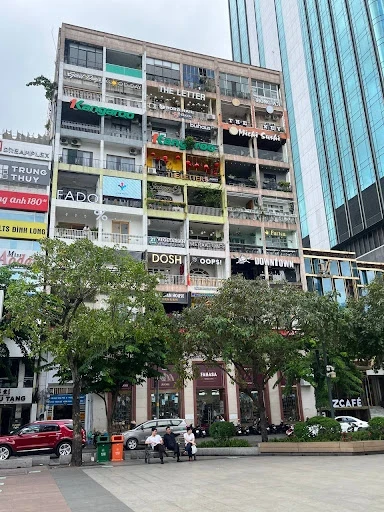
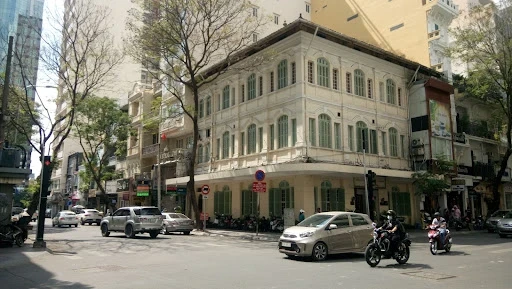
Side Trip: Nha Trang
If you have extra time after Ho Chi Minh City, Nha Trang is a great beach escape. Known
for its white-sand beaches, hot springs,
and historic sites, it's just an 8–10
hour journey by sleeper bus (~450,000 VND / $18–$19). Sleeper buses
offer reclining beds, free water, and overnight travel to save on hotel costs.
Bring snacks and warm clothing, and keep valuables with you.
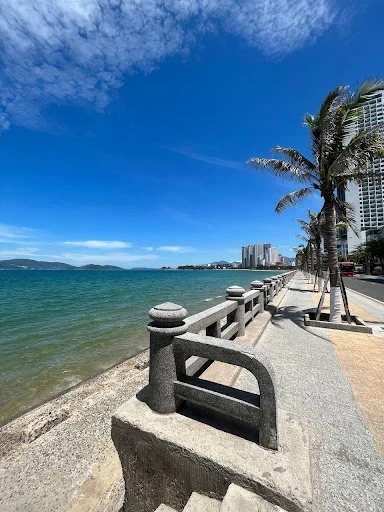
Top Attractions in Nha Trang
Po Nagar Cham Towers
The Po Nagar Cham Towers are a cluster of ancient Hindu temples built between the 7th and 12th centuries by the Cham civilization. Dedicated to Yan Po Nagar, the goddess of fertility, agriculture, and the protector of the region, this complex remains one of Nha Trang’s most important historical and cultural landmarks.
Originally,
there were ten towers, but only four have been preserved. The tallest
tower, standing at 28 meters, is
devoted to the goddess Po Nagar,
who, according to legend, taught local people vital skills such as weaving and
farming.
The site is perched on a hill overlooking the Cai River, offering panoramic views of the
sea, river, and the city of Nha Trang
from its upper terraces. The complex is located just a few kilometers from Nha
Trang's tourist center, making it easily
accessible by taxi, motorbike, or bicycle.
Visitors are advised to dress modestly, as this
is an active religious site where locals still come to pray and make offerings.
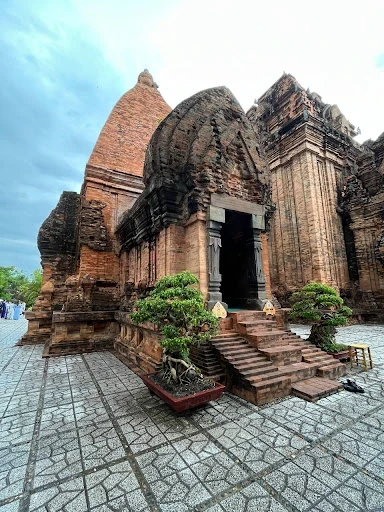
Opening Hours: 6:00 AM–5:30 PM
Entrance Fee: 30,000 VND
(~$1.20)
Long Son Pagoda
Long
Sơn Pagoda is one of Nha Trang's most iconic landmarks, famous for its
towering white Buddha statue that overlooks the city. The temple was originally
founded in 1886 by Thích Ngộ Chí, a Buddhist monk. In 1900, a powerful cyclone destroyed the
original structure, which was later relocated and rebuilt at its current
location at the foot of Trại Thủy Hill.
To reach the famous seated White Buddha (24 meters tall), visitors must climb
144 steps. Midway up the
staircase, you’ll find a peaceful statue of the Reclining Buddha, commemorating Buddhist monks who
self-immolated in protest during the Vietnam War.
Though the climb may seem challenging, the steps
are manageable, and those with limited mobility can ride a motorbike or taxi
partway up. The panoramic views of Nha Trang from the top make the effort
worthwhile.
The visit
typically takes under an hour, and respectful attire is recommended as
it remains an active place of worship.
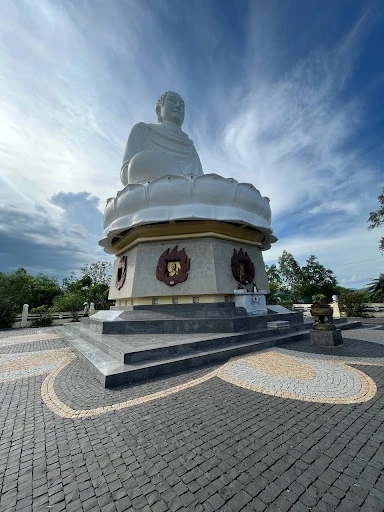
Opening
Hours: Typically 7:00 AM – 5:00 PM
Entrance Fee:
Free (donations welcome)
National Oceanographic Museum of Vietnam
The
National Oceanographic Museum of Vietnam
in Nha Trang is one of the most important marine research institutions in
Southeast Asia. Founded in 1922,
it houses thousands of specimens
of marine life, including rare and preserved species, coral samples, and
deep-sea creatures.
In addition to live aquarium displays, visitors can
explore exhibits on Vietnam’s maritime
history, fishing culture, ship models, and early marine research
tools. There's also a large skeleton of a whale on display, and some hands-on
interactive areas for children.
Located near the Cau Da port, the museum is easily accessible from central
Nha Trang and is a great educational stop for both adults and families.
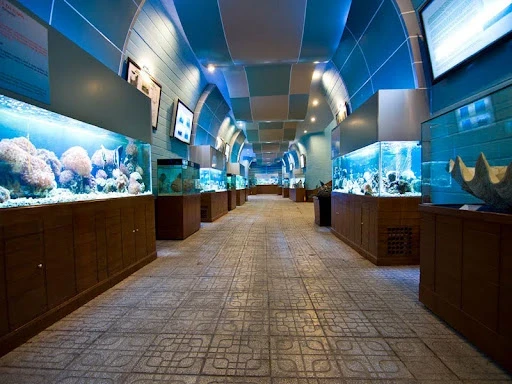
Opening
Hours: Daily, 6:00 AM – 6:00 PM
Admission Fee:
40,000 VND (~$1.60 USD); Free for children under 6
Hòn Chồng Cape
Hòn
Chồng Cape is a picturesque coastal rock formation located just a few
kilometers northeast of central Nha Trang. This granite promontory offers sweeping views of the sea, islands, and the curving Nha Trang coastline, making it a popular spot for
both sightseeing and photography.
The area is named after the most famous formation, "Hòn Chồng" (Husband Rock),
which resembles a giant handprint embedded in stone and is tied to a local
legend. A short walk from the cape takes you to a small, quiet beach, where you can swim, sunbathe, or
simply watch the waves roll in.
Nearby, you may spot local kids diving off the rocks, adding to the charm of
the place. The site also includes a café and a small cultural exhibition hall
that showcases Cham heritage and local history.
Opening
Hours: 7:00 AM – 6:30 PM
Entry Fee:
22,000 VND (~$0.90 USD)
Nha Trang Cathedral (Mountain Church)
Also
known as Christ the King Cathedral
or Nha Trang Stone Church, this
iconic landmark sits atop a small hill near the city center, offering panoramic views of Nha Trang and the sea.
Built in 1933
by French missionaries during the colonial era, the cathedral is constructed
entirely of locally quarried stone
and designed in a Gothic Revival style.
With its arched windows, stained glass, and a large clock tower, the church is
both a religious center and a popular tourist attraction.
It serves as the main Catholic church in Nha Trang, hosting regular masses
and special ceremonies. Visitors are welcome outside of mass times to admire
the architecture, take in the peaceful atmosphere, or enjoy the scenic views
from the courtyard.
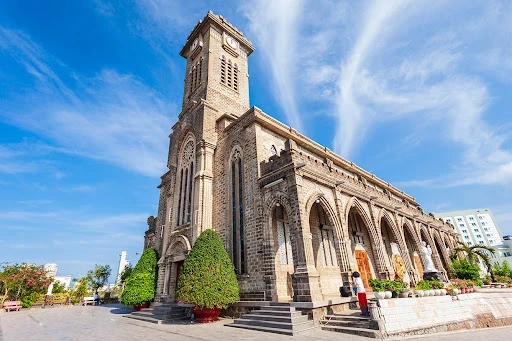
Opening
Hours: 5:00 AM – 5:30 PM
Entry Fee:
Free (Donations welcome)
Chợ Đầm Market (Dam Market)
Chợ
Đầm is one of Nha Trang’s largest
and most iconic markets, popular with both locals and tourists. Housed
in a distinctive round, lotus-shaped building, this bustling marketplace is a
great place to experience authentic
Vietnamese culture and explore the local way of life.
Inside, you’ll find a huge selection of goods, including fresh fruits,
vegetables, seafood, meats, and a variety of spices. There’s also an entire
section devoted to souvenirs, clothing,
footwear, household items, handicrafts, and more. Prices are typically
affordable, and haggling is common—especially
in the tourist-facing areas.
Whether you’re shopping for unique gifts or just
soaking in the atmosphere, Chợ Đầm offers a colorful and energetic slice of Nha Trang.
Opening
Hours: 5:30 AM – 6:30 PM
Entry Fee:
Free
VinWonders Nha Trang (Amusement Park)
Overview:
VinWonders Nha Trang, located on Hon Tre
Island, is one of Vietnam’s largest and most popular amusement parks.
Spread across a large area with stunning views of Nha Trang Bay, it features a
blend of entertainment, nature, and
cultural attractions, perfect for all age groups.
Highlights include:
- White sand beaches and resort-style pools
- Water park with wave pools and thrilling slides
- "Underwater World" Aquarium – the largest in Vietnam, home to over 300 marine species
- Family-friendly rides and extreme thrill rides
- Games zones, shopping arcades, and restaurants
- Cultural shows and amphitheater performances
Getting
There:
You can access the park by:
- Cable car (3,320 meters long) – once the longest sea-crossing cable car in the world. (Note: Cable car may be under maintenance – check current status before traveling.)
- Speedboat shuttle, included with your entrance ticket. To reach either option, take a taxi to the VinWonders Nha Trang cable car terminal on the mainland.
Opening
Hours:
- Daily: 8:00 AM – 9:00 PM (Monday–Thursday)
- 8:00 AM – 10:00 PM (Friday–Sunday & holidays)
Ticket Prices (2024):
- Children under 1 meter: Free
- Children 1–1.4 meters: 560,000 VND (~$24)
- Adults over 1.4 meters: 750,000 VND (~$32)
- Seniors: 560,000 VND (~$24)
Tip:
Due to the park’s size and variety, it’s recommended to spend a full day here. Families with
children especially enjoy the aquarium
and water park zones.
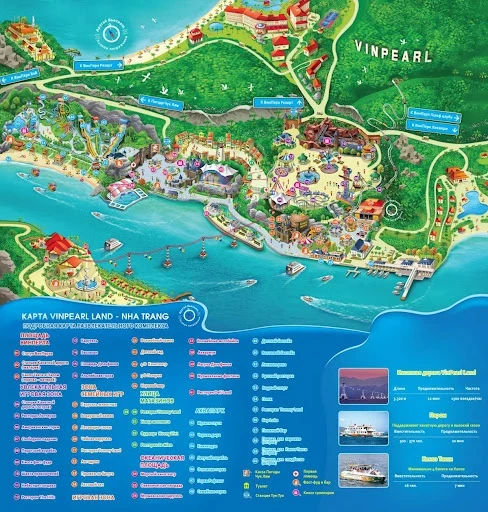
You can add one right now!